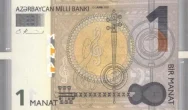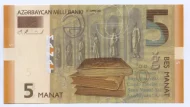Exchange your Azerbaijani Manat
Do you have leftover Azerbaijani Manat from your trip to Azerbaijan? We offer a fast and easy way to exchange both current and withdrawn Manat banknotes and coins. Don’t let your Manat sit unused – convert them into local currency today with our quick and convenient exchange service.
₼ - AZN
The Azerbaijani Manat was reintroduced in 2006 and remains the official currency of Azerbaijan, symbolizing the country's economic independence.
Azerbaijani Manat Information
The Azerbaijani Manat (AZN) is the official currency of Azerbaijan and has a unique history shaped by the country’s transition from Soviet control to independence. The manat was first introduced in 1992, shortly after Azerbaijan declared its independence from the Soviet Union. It replaced the Soviet ruble, which had been in circulation in Azerbaijan, and marked a new era in the country’s economic history.
The manat is subdivided into 100 qəpik, and Azerbaijan issues both coins and banknotes. Manat coins are available in denominations of 1, 3, 5, 10, 20, and 50 qəpik, while banknotes range from 1 to 200 manat. The design of Azerbaijani banknotes reflects the country’s rich cultural heritage and history. The notes feature symbols of Azerbaijan’s independence, economic progress, and cultural landmarks, such as the Flame Towers and images related to the country’s historical Silk Road connections.
The first manat issued in 1992 faced significant challenges due to the economic instability that followed the dissolution of the Soviet Union. Hyperinflation and political unrest during the 1990s led to a sharp decline in the value of the currency, and by 2006, the government decided to reintroduce the manat in a new, more stable form. The second Azerbaijani manat (AZN) replaced the first manat (AZM) at a rate of 5,000 AZM to 1 AZN. This redenomination was part of a broader economic reform plan aimed at stabilising the country’s economy.
Today, the Azerbaijani manat is considered one of the stronger currencies in the region, thanks in large part to the country’s wealth of natural resources, particularly oil and natural gas. Azerbaijan’s economy is heavily reliant on its energy sector, and the value of the manat is closely tied to global oil prices. The country’s central bank, the Central Bank of the Republic of Azerbaijan, oversees the issuance of the manat and implements monetary policies designed to maintain the currency’s stability.
Azerbaijan’s economy has grown significantly since the reintroduction of the manat, and the country has experienced increased foreign investment, particularly in its oil and gas sectors. The manat’s stability has been bolstered by Azerbaijan’s strategic location between Europe and Asia, as well as its role in regional trade and transportation networks. However, fluctuations in global oil prices continue to affect the value of the manat, making it vulnerable to external economic pressures.
In recent years, Azerbaijan has made efforts to diversify its economy beyond the energy sector, with investments in agriculture, tourism, and technology. These efforts aim to reduce the country’s reliance on oil exports and provide greater long-term stability for the manat. Despite these challenges, the manat remains a vital part of Azerbaijan’s financial system and a symbol of the country’s independence and economic resilience.
In summary, the Azerbaijani Manat has evolved significantly since its initial introduction in 1992. While it has faced economic challenges, it has emerged as a stable currency in the region, backed by Azerbaijan’s energy resources and strategic economic reforms.








